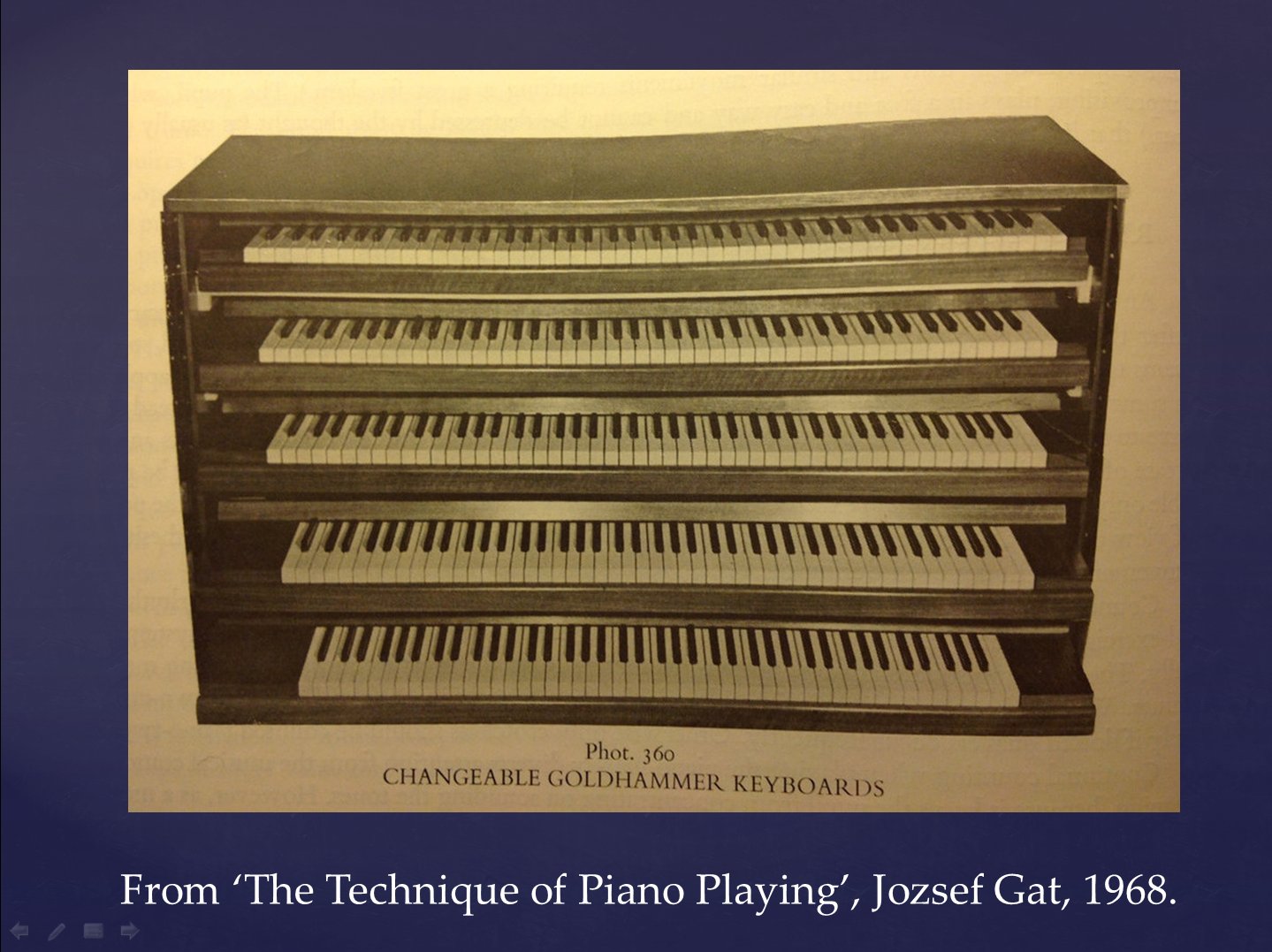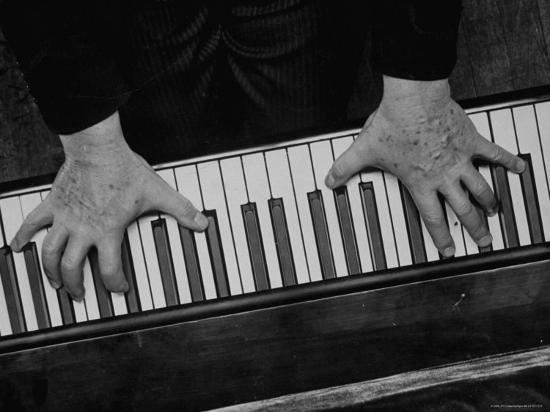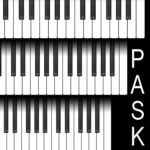Early history
Piano keyboards have not always been the size they are today; between 1784 and 1876, they mostly had narrower keys. Sakai (2008) has documented the variations in keyboard span of various keyboard instruments dating back to 1559. These range from 156 mm to 188 mm for the modern piano keyboard (measured across seven keys). Much of the best known piano repertoire was written between 1750 and 1850 at a time when the keyboard was smaller (with narrower keys) and repertoire rarely contained intervals larger than an octave. See also: https://www.piano-tuners.org/history/compass.html
Bittencourt (2022) has documented various piano keyboards with narrow keys, often designed for children, produced during the 18th and 19th centuries.
Like cooking and sewing, piano playing was seen as a highly desirable accomplishment for middle and upper class women. For them, the piano was an integral part of domestic activity, including the courting ritual. There was a clear distinction between amateurs (mostly women) who performed in the home and public performers (mostly men). In the 1800s, separate competitions were held for men and women in the Paris Conservatoire. Women were expected to be dignified, feminine and graceful, and were warned by Karl Czerny and others not to play certain types of repertoire. Direct comparisons with men were not welcomed. Teaching piano however, was an acceptable occupation for women. A Czech company did market a smaller keyboard for ‘ladies’.
During the nineteenth century, European composers such as Liszt and Kalkbrenner had strong links with the major manufacturers who built concert halls and organised recitals for these composers/virtuosi in order to market their products. Pianists such as Anton Rubinstein and Paderewski both toured the US for Steinway in the late 1800s.
Standardisation dates from the late 1880s
Today’s keyboard size dates back to about 1880, when male virtuosi were still actively involved with, and being promoted by, piano manufacturers. To produce a bigger sound in large concert halls, piano design started to incorporate cross-stringing and bigger soundboards, incorporating wider keys in order to minimise the angle of key flare.
As virtuosi performers were large-handed males (such as Paderewski and Anton Rubinstein), the slightly wider keys would not have presented a problem. The basic cross-strung design from that time, with its ‘standard’ 6.5 inch octave keyboard, has since been adopted by virtually all acoustic piano manufacturers, in both grands and uprights. Digital piano and keyboard manufacturers have simply followed suit.
Other changes during the late 19th and early 20th centuries include the use of cast iron frames which led to an increase in string tension resulting in heavier and deeper action, the lengths of keys, the height of blacks over whites, and the vertical dip of the black and white keys. As the piano evolved, the need for standardisation increased as pianists (professional and amateur) started to travel outside their own communities, hence the ‘one size fits all’ approach that has prevailed over the last century.
‘The size of the piano also affected boys and girls differently. In the eighteenth century the piano had been no bigger than a harpsichord and often smaller. At the beginning of the nineteenth century, though – with pedals appearing at floor level, the keyboard expanding in both directions, and passages in octaves appearing regularly in the newest repertory – the piano suddenly became, for children who learned it, a daunting daily reminder of how far they had to go to measure up in the adult world. Children grow at different rates, and some grow into the piano earlier than others, but many more girls than boys have felt they would never have the instrument – or the part of the repertory created by big-handed men – within their reach. Since the instrument itself has been unyielding in size, the pianist’s seat has been the principal means of helping children, or players of different sizes generally, adapt to it.’ ….Parakilas et al., 1999, Piano Roles, p.151.
Dr Ralph Manchester has summarised the problem of the ‘one size fits all’ approach:
‘Musical instrument design has evolved over time, and that is part of the problem we now face. In most cases, the designers of those instruments were men (rather than women) who lived and worked a few decades to a few centuries ago, mainly in Europe. They were likely to design instruments that they could use and that would be favored by the majority of musicians back then, who were mostly male. Today, musicians comprise a more diverse group with far more women, relatively few persons of European descent, and more persons with various physical disabilities. Nonetheless, we still play instruments that were designed for a fairly homogenous group of performers.’ (Editorial, MPPA, Dec 2006.)
Since 1880, there has been an enormous increase in women undertaking tertiary level training with the aim of pursuing performing careers, as well as a dramatic growth in the number of piano students of Asian ethnicity. Women have hands approximately 15% smaller than men, and Asians have smaller hands than Caucasians. In addition, 20th century piano repertoire often requires larger hand spans than repertoire composed during the 17th to 19th centuries.
However, during the 20th century some companies did experiment with narrow key models or other inventions to reduce the strain for ‘small hands’ playing the conventional keyboard, but they could not compete with mass production and promotion of the ‘standard’ 6.5 inch keyboard. Some companies produced pianos with double keyboards, such as the Bosendorfer grand piano with double keyboard, Yamaha’s ‘educational’ double keyboard upright in the 1940s included a lower keyboard designed for small children until their hands grew sufficiently to enable them to play the ‘large’ keyboard. Narrower key pianos (small grands and uprights) by both Yamaha and Kawai were offered in a limited way, in Japan only, during the 1990s; they were actively promoted by Yoshinao Nakada until his death in 2000.
In 2000, the Dutch piano company Andriessen starts offering a ‘Kinderklavier’ (‘children’s piano) with narrow keys (7/8 and ¾) inserted into a Yamaha U1 upright. Unfortunately only two years later, Frans Willem Andriessen died and the project was discontinued.
The following images show a restored Yamaha with double keyboard, and the Goldhammer keyboards patented in 1958.


Josef Hofmann
Notable exceptions since 1900 include a keyboard with narrower keys specially made by Steinway & Sons for the famous virtuoso, Josef Hofmann, early last century.
Written evidence provided by Steinway Hamburg to Prof Dr Christoph Wagner (founder and director of the Hanover Institute of Music Physiology, 1974-1993) in 1986 states that the Hofmann keyboard was 3.5 cm narrower than normal. This means an octave width of 16 cm (6.3 inches), 0.5 cm less than normal.
While his hand span was not particularly small, it was undoubtedly smaller than many other famous male concert pianists at the time. But his hands were larger than the majority of adult women today! It is interesting that even HE wanted ‘larger hands’. See the photo of his hands here ——->

The invention and development of the DS Standard® piano keyboard with narrower keys
In the early 1990s, Christopher Donison, a pianist, composer and conductor from British Columbia, Canada, met up with Pennsylvanian textile manufacturer and engineer, David Steinbuhler. Together they created a second official keyboard size (the DS standard®), with the long term aim of it becoming universally available.
The first prototype keyboard was built by Steinbuhler & Company in 1994. The company’s first sale in 1996 was to Canadian pianist, Linda Gould, who flew from British Columbia in Canada to try it out. She made an immediate decision to buy a DS5.5® keyboard for her Yamaha grand piano. You can hear her story here: https://www.youtube.com/watch?v=Jn9-c8n0Q3s&list=PLHBn-VaaOCGcAanKWSo7pCA0GFfQa7N1b
Between 1998 and 2005, Steinbuhler invited adult pianists to experiment with a complete range of piano keyboard sizes at their centre in Titusville, Pennsylvania. Participants were able to spend hours or days experimenting and swapping between the different size keyboards. It became clear there was a strong desire for at least two smaller keyboard sizes in addition to the conventional keyboard. To determine the most practical sized keyboard for the smaller-handed pianists, a detailed study was conducted using five keyboards measuring between 38 and 42 inches (96.5-106.7 cm) in overall width. About 15 pianists experimented with these keyboards. Although there was a general desire to play the smallest keyboards, it was found that below 40 inches, the space between black keys became too cramped for all but those with the smallest hands with thin fingers.
Hence, in 2000, Southern Methodist University in Texas, the first US university to retrofit a piano with an ESPK (ergonomically scaled piano keyboard)* keyboard, chose the DS5.5® as the best available choice for the smaller hand sizes. Dr. Carol Leone, Chair of Keyboard Studies at SMU, began to research the benefits of the keyboards. These small keyboard actions can also be installed in pianos of the same make and model with minimal technical adjustment. Dr. Leone travelled with her keyboard action and demonstrated its use at other American universities. Most of these universities consequently acquired their own DS keyboard actions for student use and further research .
Three standards were subsequently defined (octave measurements given represent the total width of seven white keys) as follows:
DS6.5™ (Conventional keyboard) – 6.5 inch (16.5 cm) octave, 48.29 inches (122.7 cm) total width
DS6.0® (Universal keyboard, 15/16 width of conventional – 6.0 inch (15.2 cm) octave, 44.57 inches (113.2 cm) total width
DS5.5® (7/8 keyboard, 5.54 inch (14.1 cm) octave, 41.14 inches (104.5 cm) total width.
More recently, David Steinbuhler has added a smaller size:
DS5.1® (Child’s keyboard, 5.11 inch (13.0 cm) octave, 37.94 inches ( 96.37 mm) total width.
The size of the Hofmann keyboard mentioned above was between the DS6.5™ and DS6.0® sizes, with a 6.3 inch octave.
The 21st century
The momentum for change has continued, with the formation of the PASK network, early steps taken by companies such as Hailun, and startups such as Kaduk making use of digital technology.
In recent years, renowned pianist and conductor, Daniel Barenboim, has been travelling and performing on pianos with narrower keys. His keyboards, made by Kluge, have a width much the same as those used by Josef Hofmann a century ago, i.e. a 6.3 inch octave.
The Steinbuhler company has been converted to a non-profit known as the DS Standard Foundation, which continues to manufacture acoustic DS® keyboards and make these available on loan to universities. https://dsstandardfoundation.org
References and links
Daniel Barenboim interview 2008: http://www.nytimes.com/2008/11/23/arts/music/23kimm.html?pagewanted=all&_r=2&
Bittencourt de Assis Periera , R. (2008). Anne Elisabeth Cécile Soria (ca. 1766 – 1843) et les claviers de piano ergonomiques. Sorbonne University, Paris.
Bosendorfer grand piano with double keyboard: https://www.metmuseum.org/art/collection/search/503040
Booker, E., & Boyle, R. (2011). Piano keyboards – one size does not fit all! Pianistic health for the next generation. Proceedings of the 10th Australasian Piano Pedagogy Conference: Leading Notes to Effective Teaching: Resolving the past – Exploring the future. Charles Sturt University, Wagga Wagga, 4-8 July 2011. https://appca.com.au/proceedings/proceedings.html
Deahl, L. & Wristen, B. (2003). Strategies for small-handed pianists. American Music Teacher, 52 (6), 21-25.
Donison, C. (1998). Small hands? Try this keyboard, you’ll like it. Piano & Keyboard, July-August, 41-43.
Donison, C. (2000). Hand size versus the standard piano keyboard. Medical Problems of Performing Artists, 15, 111-114.
Manchester, R. (2006). Musical instrument ergonomics (editorial). Medical Problems of Performing Artists, 21 (4), 157-158.
Parakilas, J. & others. (1999). Piano Roles: Three Hundred Years of Life with the Piano, Yale University Press, New Haven and London.
Sakai N. (2008) Keyboard span in old musical instruments. Medical Problems of Performing Artists, 23, (4),16-171. https://go.gale.com/ps/i.do?p=AONE&u=googlescholar&id=GALE|A197797337&v=2.1&it=r&asid=0736156d
Wagner, Ch. (2005) Hand und Instrument. Breitkopf & Härtel, Wiesbaden-Leipzig-Paris, p. 228-240.


